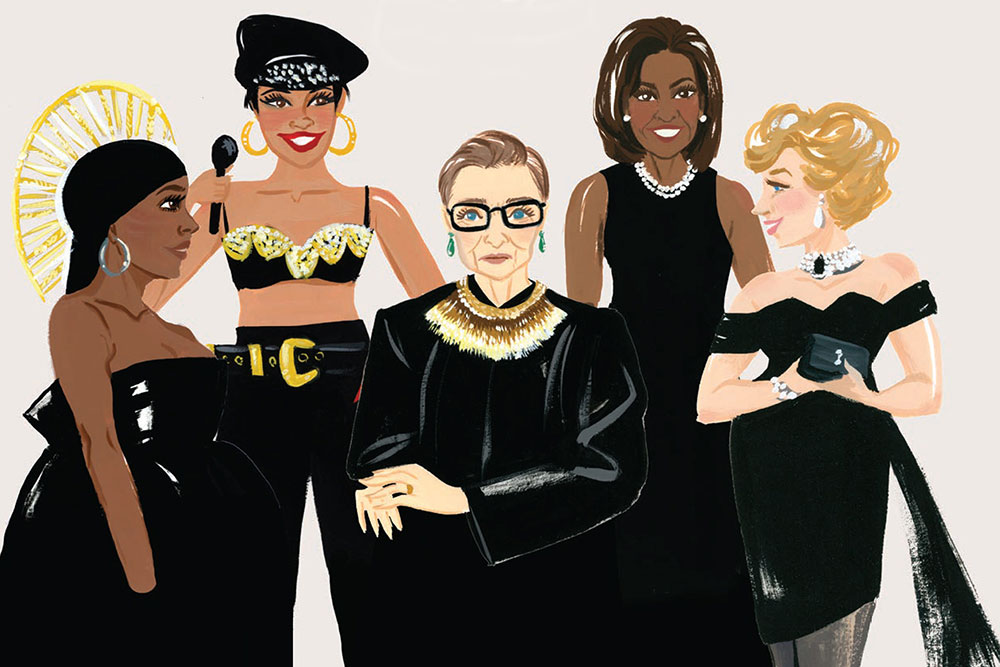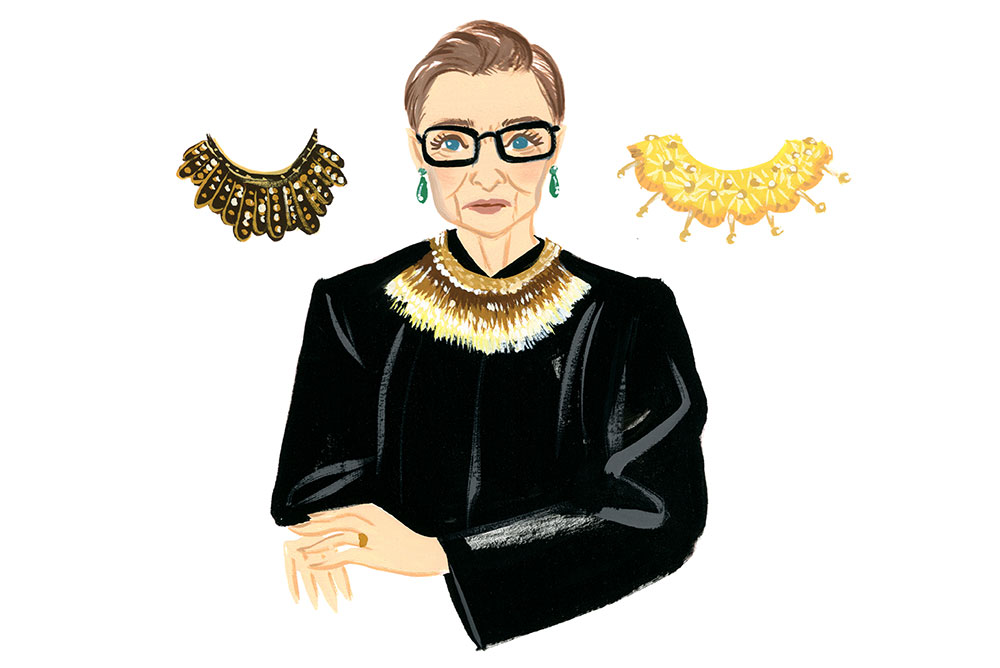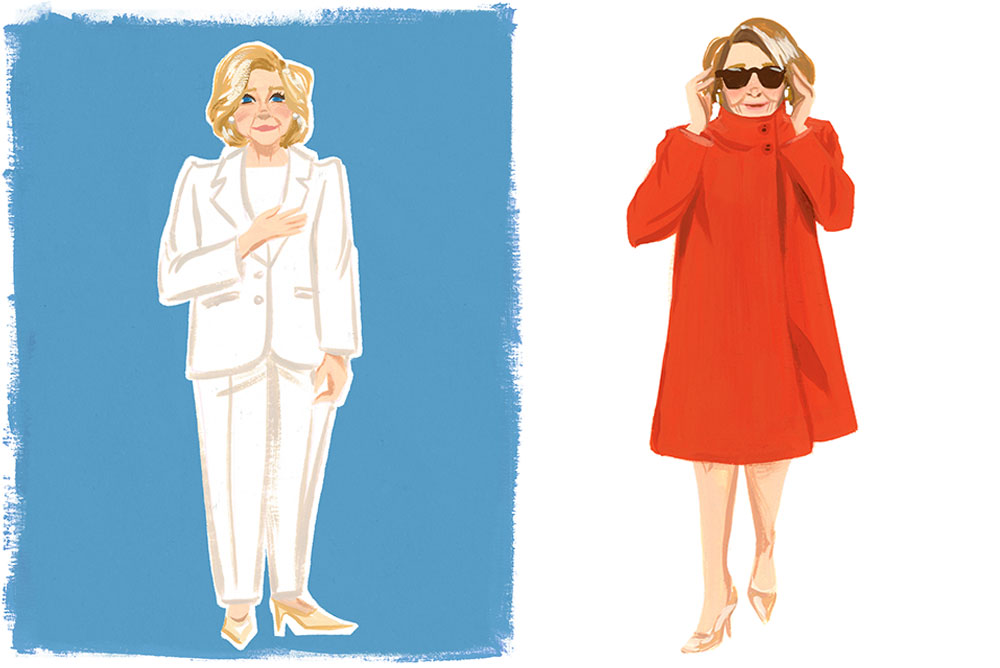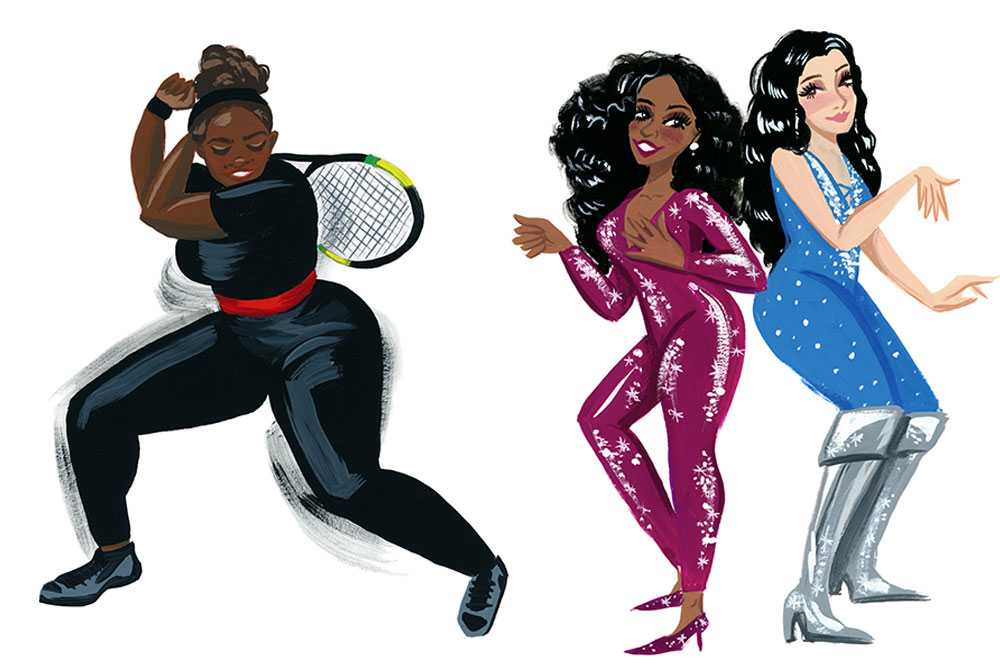
FROM LEFT TO RIGHT: Women who used the power of fashion to make a personal statement: Solange Knowles at the 2018 Met “Heavenly Bodies” Gala in an Iris Van Herpen gown and a durag (a staple of Black culture) with a halo headpiece. Mexican-American singer Selena Quintanilla was known for her fearless style, which is still copied today, 25 years after her senseless murder. Ruth Bader Ginsburg in an official 2018 portrait of the Supremes after the confirmation of Bret Kavanaugh. Michelle Obama wearing her signature sleeveless black shift, defying critics, showing off her beautiful, sculpted arms. And Princess Diana, resplendent in her “revenge dress.” She wore it the same night Prince Charles admitted to adultery on national TV, turning a humiliating moment into a personal victory.
CLOTHES can speak volumes. So says ANN SHEN’s new book, Nevertheless, She Wore It: 50 Iconic Fashion Moments ($22.50 Chronicle Books), a fun, informative, illustrated romp through fashion history, zeroing in on sartorial choices that defined their time. From Marie Antoinette’s excoriated gaulle (a simple muslin dress loosely draped around the body and belted around the waist with a sash) to Serena Williams’s oh-so scandalous sleek black Nike catsuit, Shen explains how generations of women have used the power of fashion to make a political and/or cultural statement.
Looks include the Flapper Dress, the unofficial outfit of women’s independence in the 1920s; the Afro, the hairstyle that was an emblem of Black beauty, power and pride; and the Mini Skirt, which became a symbol of liberation and rebellion against the post-war 1950s.
There also are nods to Marlene Dietrich and the tuxedo, Coco Chanel and the tweed suit and to statement-making red. Shen cites the story of Supreme Court Justice Sonia Sotomayor, who was advised to wear neutral nail polish instead of red for her confirmation hearings. She didn’t listen to the advice.
Here, more examples of the clothing women wore that changed the way we think about how we dress.
—Janet Kelly

The late, great RUTH BADER GINSBURG changed the world for women, fighting all her professional life for gender equality. Shy and diminutive, she became a rock star in her 80s. Her special-occasion collars served as her personal code. When announcing an opinion for the court, she wore a yellow crochet jabot with pink edges that features a chain and gold appliqués (a gift from her law clerks). To express dissent over a court ruling, Ginsburg opted for a black bib necklace with rhinestones, because “it looks fitting for dissent.” In the official photo of all nine justices in 2018 after Justice Brett Kavanaugh joined the Court, Ginsburg wore a spiky feathered collar, made by accessories company Stella & Dot. Make of it what you will.

LEFT: It wasn’t until 1993 amid challenges by Senators Carol Moseley-Braun and Barbra Mikulski that women started wearing pantsuits on the Senate floor. HILLARY CLINTON rewrote the rules about women’s clothing in the political scene. She chose to take on the power of the suit, reflecting her personal preferences and personality through them. She was known for her colorful pantsuits, but as a nod to suffragettes she wore a white one to accept her presidential nomination, the first for a woman of a major political party.
RIGHT: Speaker of the House NANCY PELOSI’s first meeting with Donald Trump came after the 2018 midterm elections when the Democrats won control of the House and Pelosi regained her Speaker role. After a contentious session, she emerged in this high-collared, fire-engine red coat from Max Mara, accessorized with dark sunglasses and high heels. Not just clothes, but “diplomacy in motion,” award-winning filmmaker Barry Jenkins noted.

LEFT: In 2018, after the birth of her daughter, SERENA WILLIAMS returned to tennis wearing a black Nike catsuit with a red sash about which she said, “I feel like a warrior princess… like a superhero when I wear it.” The French Tennis Federation banned it from future French Open tournaments and critics voiced their displeasure (read sexism and racism). Despite the criticism of what she wears and how she plays, Serena keeps winning, a real-life superhero to her followers and fans.
RIGHT: Jumpsuits (boilersuits, coveralls), which started out as garments for manual workers, became a popular style for women in the 1970s, thanks to the likes of Cher and DIANA ROSS. In 1983, Ross became the first woman Black singer to headline a show in Central Park. As rain began falling, Ross told the 450,000-person audience, “It took me a lifetime to get here, and I’m not going anywhere.” She celebrated her powerful stardom in a purple sequined jumpsuit, inspiring a future generation, notably Beyoncé and Jennifer Lopez.

Women have had to speak through their clothing when they haven’t had a voice. The strength of these choices is inspiring. Great column, Janet. Happy holidays to all Little Birds.
Thanks, Nancy, so glad you liked it. Happy Holidays to you and yours. xx
These are worth noting. “Nevertheless She Wore It” would also make a good title for the irrational and outrageous get-ups some women manage to get away with!
Loved this column, Janet! Strong feminists, speaking softly, peacefully, yet so clearly, through their fashion choices. That’s inspiring!
xo
Awesome! Love seeing these powerful women wearing game-changing clothes
Merry Christmas Janet
Thanks, Carol. Have a very Merry Christmas. Thanks, as always, for reading MyLittleBird. xx